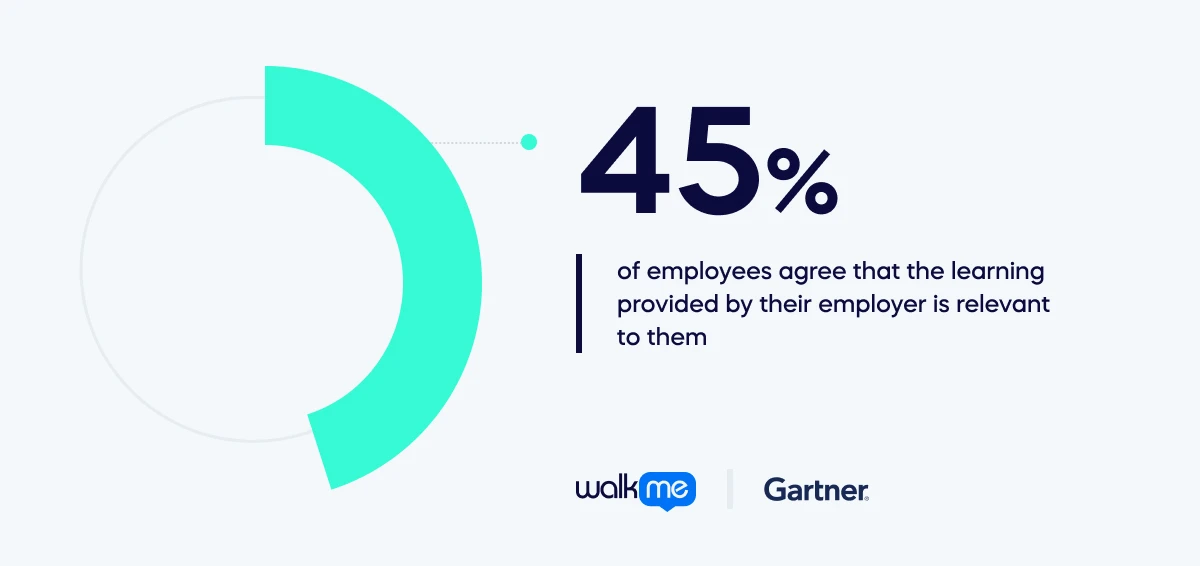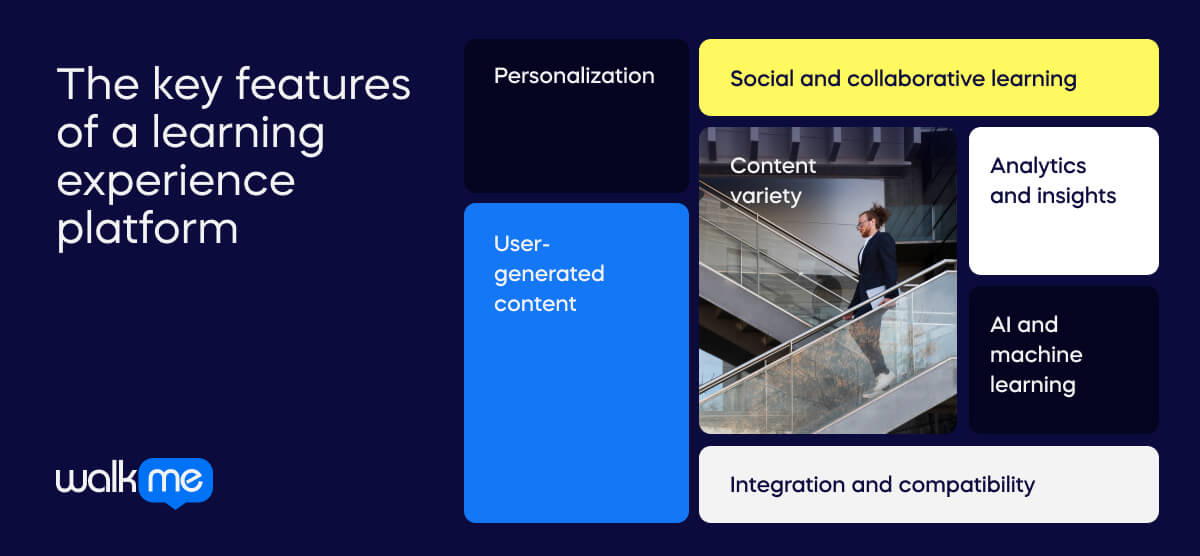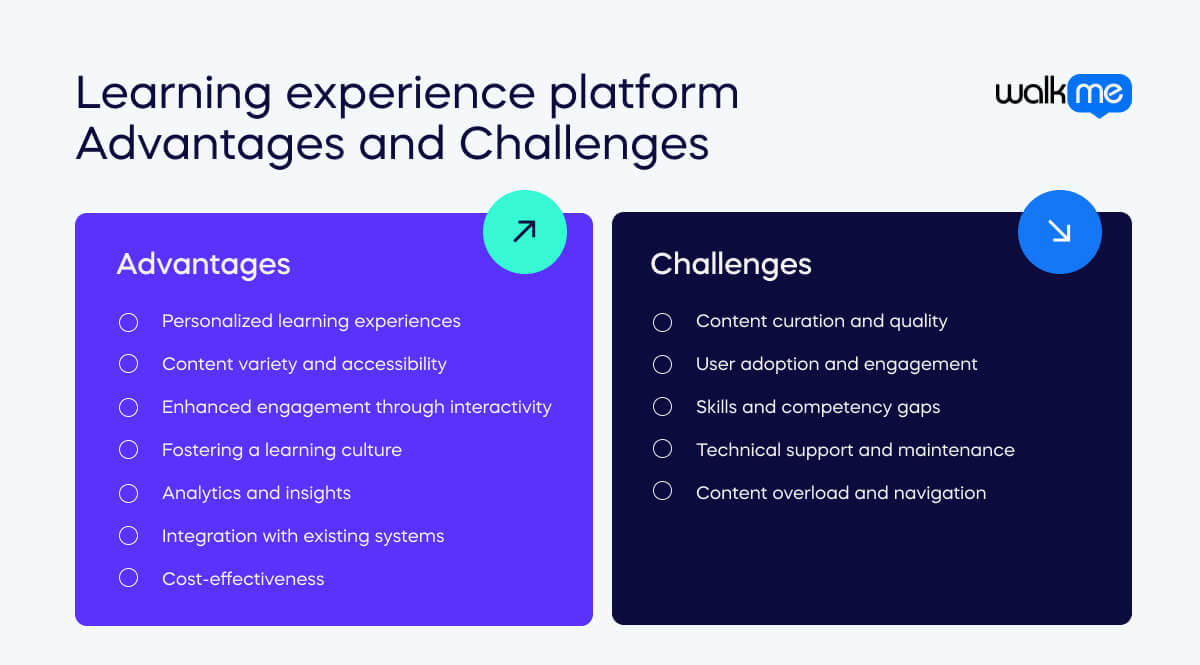What is a learning experience platform?
A learning experience platform, or LXP, is a digital learning environment. It puts the learner’s experience first by offering personalized content and experiences. It differs from traditional Learning management systems (LMS). This is achieved by focusing on a more engaging and user-centric approach to learning.

LXPs typically use data analytics and AI to tailor learning paths to individual learners. They encourage social learning through collaboration tools and support many content formats beyond traditional courses. The demand for LXPs is increasing. Statistics reveal that the market is expected to reach $9021.38 million by 2028. Furthermore, Gartner reveals that just 45% of employees agree that the learning provided by their employer is relevant to them. This is where digital learning solutions such as LXPs can bridge the gap.

Overall, LXPs aim to enhance learning effectiveness and engagement by adapting to learners’ needs and preferences.
What are the key features of a learning experience platform?

As mentioned above, LXPs are uniquely designed to adapt to learner needs, creating a dynamic and engaging environment. To achieve this, learning experience platforms use several key features. These include the following:
Personalization
LXPs offer personalized learning experiences tailored to each learner’s needs. These may include customized content recommendations, adaptive learning paths, and customization options.
Content variety
They offer a wide range of learning content types beyond courses, including videos, podcasts, articles, and interactive modules.
Social and collaborative learning
LXPs often have social learning features such as discussion forums. These encourage knowledge-sharing and collaborative problem-solving.
User-generated content
Some LXPs allow users to create and share their own content, such as courses, articles, or videos. This creates a culture of knowledge sharing and supports informal learning.
Analytics and insights
They track learner progress, engagement, completion rates, and learning outcomes. This helps administrators and instructors to assess the effectiveness of learning programs. They can find areas for improvement and make learning experiences more personal.
Integration and compatibility
LXPs are designed to integrate with other learning management systems (LMS), human resource information systems (HRIS), content management systems (CMS), and other enterprise tools.
AI and machine learning
Some LXPs use AI and machine learning. They automate content recommendations and personalize learning paths in real-time. They predict learner behavior and provide adaptive learning.
Learning experience platform vs learning management system
A learning experience platform (LXP) may sound similar to —or the same as—a learning management system (LMS). Both of them are important for delivering digital learning. However, there are some key differences to be aware of:
- LXPs focus on personalized and collaborative learning experiences
- LMSs manage and deliver educational or training courses, ensuring compliance
Let’s take a closer look at how the terms differ:
| LXP | LMS | |
| Definition | A digital learning environment that focuses on delivering personalized learning experiences. It emphasizes learner engagement and social learning features. | A software application used for administration, documentation, tracking, reporting, and delivery of educational courses or training programs. It typically focuses on managing learning activities, course content, and learner progress. |
| Focus | Personalized learning experiences Learner engagement Social and collaborative learning Content variety | Course administration Tracking learner progress Managing course content Compliance training Certification tracking Reporting |
| Techniques | Personalizing content Recommending content with AI Social learning features, e.g., discussion forums Allowing user-generated content Gamification | Managing courses Keeping track of enrollment Using tools to grade and assess learners Producing and managing content Tracking and reporting on learner progress Monitoring compliance and learner certification |
| Goals | Increasing learner engagement Improving learning outcomes through personalized experiences Fostering collaboration and knowledge sharing Adapting learning paths to individual needs | Administering learning programs efficiently Tracking and reporting on learner progress Ensuring compliance with training requirements Managing and delivering course content effectively |
| Examples of use | Used in corporate training settings to provide: personalized onboarding experiences skills development programs continuous learning initiatives Examples include Degreed, Cornerstone Learning Experience Platform and EdCast. | Widely used in schools, universities, and corporate environments for managing and delivering formal learning programs. Examples include Moodle, Blackboard, Canvas (in education), SAP Litmos, TalentLMS, and Docebo (in corporate settings). |
Use cases for learning experience platform
A learning experience platform can provide many benefits for companies, but it can be difficult to understand how they work in practice. LXPs can help workers fill in knowledge gaps and collaborate with colleagues to share insights. Once workers are engaged with a platform, businesses benefit from an upskilled workforce and happier clients. Here are three examples of how an LXP can be used in various corporate scenarios.
Onboarding and employee training
- A large multinational corporation wants to make onboarding easier and improve employee training.
- They roll out an LXP that provides personalized onboarding based on the new employee’s role, background, and skill level.
- The platform includes interactive modules, videos, and social learning features.
- New hires can access resources anytime, anywhere, providing a self-paced learning environment.
- Analytics help HR managers track progress. They can assess the onboarding program’s impact on employee engagement and retention.
Sales enablement and product training
- A technology company launches a new product. It needs to train its global sales team on its features, benefits, and competitive positioning quickly and effectively.
- They use an LXP to deliver product training modules. These are tailored to different sales roles (e.g., sales managers and technical sales specialists).
- The platform includes multimedia content, quizzes, and virtual labs to simulate product usage.
- Social learning features allow sales reps to share best practices and collaborate on sales strategies.
- AI-driven recommendations guide learners to relevant content based on their knowledge gaps.
- By continuously assessing learners and gathering feedback, the LXP can be improved to optimize training outcomes and sales performance.
Professional development and skills enhancement
- A financial services firm wants to train its workers on emerging technologies and industry trends to stay competitive.
- They use an LXP that builds learning pathways focusing on specific skills such as data analytics, blockchain technology, and regulatory compliance.
- The platform uses content from external providers, industry experts, and internal subject matter experts.
- Users complete microlearning modules, participate in webinars, and contribute to discussion forums to share insights and experiences.
- AI algorithms recommend personalized learning tracks based on skill gaps identified through performance assessments.
- The firm tracks ROI through improved employee competencies, reduced training costs, and increased client satisfaction.

What are the advantages of a learning experience platform?
LXPs offer many benefits that improve learning and help organizations succeed. They use technology to create engaging, personalized learning experiences that boost performance and satisfaction. Here are some key advantages of using an LXP:
Personalized learning experiences
LXPs use algorithms and AI to deliver personalized learning paths. Learners receive content and activities that are most beneficial to them.
Content variety and accessibility
Users can enjoy various learning content beyond traditional courses, including videos, articles, podcasts, simulations, and interactive modules.
Enhanced engagement through interactivity
Interactive elements such as quizzes and discussion forums are often available. These features promote active learning, collaboration among learners, and knowledge sharing.
Fostering a learning culture
Employees can embark on their own learning paths, exploring new topics and staying updated with industry trends. They can take control of their own skill development.
Analytics and insights
Thanks to strong analytics features, administrators can understand engagement levels, track progress, and measure the effectiveness of learning programs.
Integration with existing systems
LXPs are designed to integrate with other learning management systems (LMS), human resource information systems (HRIS), and enterprise tools.
Cost-effectiveness
Implementing an LXP can lead to cost savings compared to traditional training methods. LXPs reduce expenses related to physical training facilities, travel, and instructor-led sessions.
What are the challenges of a learning experience platform?
Now, let’s explore the challenges of learning experience platforms. While these tools are designed to improve upskilling in the workplace, organizations may need to address some challenges. Addressing them requires careful planning, stakeholder engagement, continuous evaluation, and adaptation of strategies. Let’s take a closer look:
Content curation and quality
Managing and curating high-quality, relevant content can be a challenge. Ensuring that the content meets diverse learner needs, is up-to-date with current trends, and aligns with organizational goals requires continuous effort and resources.
User adoption and engagement
While LXPs are designed to enhance engagement, user adoption can be a challenge. Encouraging learners to actively use the platform, participate in social learning activities, and take ownership of their learning journey requires effective communication, training, and change management strategies.
Skills and competency gaps
Implementing an LXP may reveal skills and competency gaps among learners and within the organization. Addressing these gaps requires strategic planning and investment in professional development resources.`
Technical support and maintenance
LXPs require ongoing technical support, maintenance, and updates like any digital platform. It is vital for success to ensure the platform operates smoothly, resolve technical issues promptly, and provide user support.
Content overload and navigation
The abundance of learning content available in LXPs can sometimes overwhelm learners. Therefore, it is essential to design intuitive user interfaces, effective search functionalities, and content categorization to help learners navigate and discover relevant content efficiently.
How can DAPs help with a learning experience platform?
Digital adoption platforms (DAPs) can complement Learning Experience Platforms (LXPs) in several ways to enhance the learning experience. By rolling out these tools together, they can improve user adoption of digital tools within organizations. Features such as contextual guidance, support, and analytics can enhance user onboarding, engagement, feature adoption, and overall learning effectiveness. Let’s take a closer look at how they can help:
Onboarding and training
DAPs can provide contextual guidance and walkthroughs within the LXP interface to help new users navigate the platform effectively. This guidance ensures learners quickly understand how to access content, participate in courses, and use various features.
Feature adoption
LXPs often offer a variety of features and functionalities that users may not immediately understand or know how to use to their full potential. Fortunately, DAPs can deliver in-app guidance and tooltips explaining their work. This encourages learners to explore and use advanced features for a richer learning experience.
Change management
When organizations introduce new features, updates, or changes to their LXPs, DAPs can play a crucial role in facilitating change management. They can provide real-time notifications, announcements, and step-by-step guidance to inform users about changes.
Performance support
During learning activities within the LXP, users may encounter challenges or need quick assistance. DAPs can offer contextual help and support directly within the LXP interface, providing instant answers.
Analytics and insights
DAPs often include analytics dashboards that provide visibility into user behavior, engagement patterns, and adoption rates. By analyzing these insights, administrators can identify areas where users may need additional support or training. They can also work to optimize the user experience and tailor learning pathways to improve engagement and learning outcomes.
Continuous improvement
DAPs support continuous improvement efforts by capturing user feedback, sentiment analysis, and performance metrics related to the LXP. This data helps administrators and learning experience designers identify opportunities to enhance the platform. Furthermore, they can refine content delivery to address user needs and preferences.